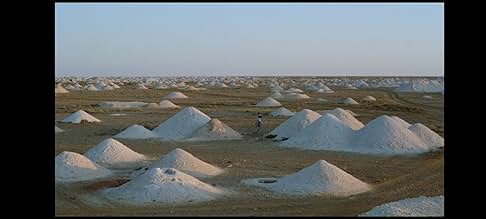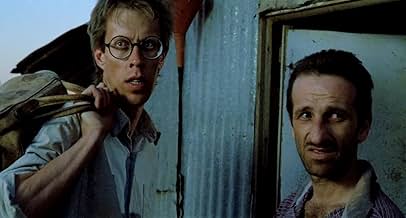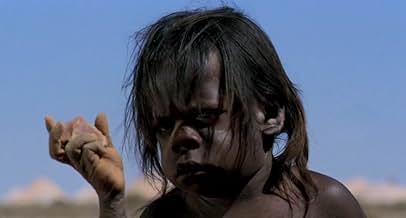Le pays où rêvent les fourmis vertes
Original title: Wo die grünen Ameisen träumen
- 1984
- Tous publics
- 1h 40m
IMDb RATING
6.9/10
2.8K
YOUR RATING
A geologist employed by an Australian mining company finds himself disputing the rights of some aborigines who believe their land to be sacred.A geologist employed by an Australian mining company finds himself disputing the rights of some aborigines who believe their land to be sacred.A geologist employed by an Australian mining company finds himself disputing the rights of some aborigines who believe their land to be sacred.
- Awards
- 2 wins & 2 nominations total
- Director
- Writers
- All cast & crew
- Production, box office & more at IMDbPro
Featured reviews
I also remember this film as life-changing. I saw it at the TIFF many years ago and was baffled by it.
There is a small scene in an elevator that I remember as a transcendent cinematic moment.
Like so many of Herzog's films, it is deeply moving for reasons that aren't easy to put your finger on - often with Herzog it's an odd juxtaposition, an awkward silence, a strange edit, an inappropriate flash of humour or horror that produce a flash of insight.
This film, at the time, seemed conventional by Herzog's standards, but I still left the theatre feeling slightly drugged, always a good sign.
There is a small scene in an elevator that I remember as a transcendent cinematic moment.
Like so many of Herzog's films, it is deeply moving for reasons that aren't easy to put your finger on - often with Herzog it's an odd juxtaposition, an awkward silence, a strange edit, an inappropriate flash of humour or horror that produce a flash of insight.
This film, at the time, seemed conventional by Herzog's standards, but I still left the theatre feeling slightly drugged, always a good sign.
I hadn't thought that Herzog was capable of making a good film without Kinski, only some pretentious artsy thing like Heart of Glass.
Well, Green Ants proves me wrong. This is a great film that shows the conflict between white and aboriginal civilizations without being sentimental or condescending to either side. With Hollywood we'd some cliché about noble savages and suchlike, but here you get the feeling of dealing with real human beings.
Oh yeah, the plot deals with an Australian mining company that wants to blow up a sacred site to do mineral exploitation. Herzog avoids stereotyped poses to bring out the situation as it would occur in real life. Plus you get some great shots of the outback.
I plan to lend this one to all my aboriginal friends!
Well, Green Ants proves me wrong. This is a great film that shows the conflict between white and aboriginal civilizations without being sentimental or condescending to either side. With Hollywood we'd some cliché about noble savages and suchlike, but here you get the feeling of dealing with real human beings.
Oh yeah, the plot deals with an Australian mining company that wants to blow up a sacred site to do mineral exploitation. Herzog avoids stereotyped poses to bring out the situation as it would occur in real life. Plus you get some great shots of the outback.
I plan to lend this one to all my aboriginal friends!
I'm invariably surprised when I mention this film to friends that they say they've never seen it. Werner Herzog in Australia? C'mon. How could the great German director of Wozzeck, Nosferatu and other Gothic classics concern himself with a very oblique tale of a development project impeded by Aboriginal Australians who contend that disturbing the green ants dreams by ripping up their habitat will likewise rip the fabric of the universe? The government solution is to give them an airplane which one of the younger members of their tribe eventually manages to take off with a number of the elders on board. Looking over the cast, you likely not recognize names that most of us who don't follow Aussie films know; some of us may know Bruce Spence from the Mad Max films who plays a geologist, but there are many Australian Aborigines. A poignant moment is seen in the court room scene where one Aborigine rises to speak and the judge asks for a translation, only to be told the men is called "the Mute" because there's no one left who understands his tribal language.
The overall effect of the film is wonderfully Herzog with a surrealistic portrayal of the clash of old and new, progress versus conservation and fraught with cultural miscommunication. I really recommend this film for your viewing.
The overall effect of the film is wonderfully Herzog with a surrealistic portrayal of the clash of old and new, progress versus conservation and fraught with cultural miscommunication. I really recommend this film for your viewing.
Where the Green Ants Dream- at the least featuring one of Werner Herzog's best titled films as it's one of those amazing visuals one gets out of the strangest of the director's work- is placed in a somewhat minor cannon of the German maverick's work, and maybe rightfully so. It's about a controversial topic, that of the rights of the Aborigines and the Australian's seeming right via original British Imperial rule, and it features practically all non-professional actors and some shaky transitions between its sturdy plot and non-sequiters and quintessential Herzogian landscapes. If I were recommending Herzog films to a friend this wouldn't be at the top of the crop (unless of course one is fervently into Australian issue movies or love that one song from the 80s "Beds are Burning"). But it's by no means an over-ambitious quagmire like Heart of Glass, and at worst it's occasionally dull or, and I hate to say this for Herzog, too eccentric for its own good.
It's not to say some of Herzog's bits of character eccentricities aren't out of place. There's featured here amid the story of an aboriginal tribe peacefully protesting and standing their ground against construction on a sacred land of the title name various strange bits of business. My favorite was that mid-section involving the Aborigines asking for a plane, assumed on the part of the construction group as part of the negotiations, and features in one of the oddest parts of the movie the one black pilot from the Aussie air force who keeps singing "My baby does the hanky-panky" to himself. And there's some cool visuals of stock tornado footage and those barren wastelands and perplexing dunes and pyramid-hills in the desert plains that provide the director some choice locations to film. It's hard not to see for the Herzog fan some allotment of poetry.
But there are some problems that I couldn't quite ignore. Despite the acting force of Bruce Spence, who displays far more here as a gifted actor (contrary to what another IMDb reviewer said) and as more than just the kooky flier in the Mad Max movies, the acting is in general fairly weak and at best standard and too off-kilter. It's fairly distracting when Herzog can't quite corral his actors as well as with his technical skills; this also despite some real 'presence' with the two aboriginal chiefs. And certain big scenes, like the courtroom, aren't as effective as might have been intended and come off as dry and too naturalistic and stuffy.
And yet, even with these qualms, it's got some real courage and conviction with its message, which is that aside from the typical "respect the native culture" beat is that people need to learn to live together and not have cultures lost and squandered in the face of bigotry and imperialistic attitudes that should have been squashed decades ago. It's a very good, if not great, examination of a meeting of two societies and an identification of "the other" by a filmmaker willing to take it on. 7.5/10
It's not to say some of Herzog's bits of character eccentricities aren't out of place. There's featured here amid the story of an aboriginal tribe peacefully protesting and standing their ground against construction on a sacred land of the title name various strange bits of business. My favorite was that mid-section involving the Aborigines asking for a plane, assumed on the part of the construction group as part of the negotiations, and features in one of the oddest parts of the movie the one black pilot from the Aussie air force who keeps singing "My baby does the hanky-panky" to himself. And there's some cool visuals of stock tornado footage and those barren wastelands and perplexing dunes and pyramid-hills in the desert plains that provide the director some choice locations to film. It's hard not to see for the Herzog fan some allotment of poetry.
But there are some problems that I couldn't quite ignore. Despite the acting force of Bruce Spence, who displays far more here as a gifted actor (contrary to what another IMDb reviewer said) and as more than just the kooky flier in the Mad Max movies, the acting is in general fairly weak and at best standard and too off-kilter. It's fairly distracting when Herzog can't quite corral his actors as well as with his technical skills; this also despite some real 'presence' with the two aboriginal chiefs. And certain big scenes, like the courtroom, aren't as effective as might have been intended and come off as dry and too naturalistic and stuffy.
And yet, even with these qualms, it's got some real courage and conviction with its message, which is that aside from the typical "respect the native culture" beat is that people need to learn to live together and not have cultures lost and squandered in the face of bigotry and imperialistic attitudes that should have been squashed decades ago. It's a very good, if not great, examination of a meeting of two societies and an identification of "the other" by a filmmaker willing to take it on. 7.5/10
Herzog is a simple man, easy to read. Hearing him talk of his films, one gets bored easily.
His films are simply conceived, like Lynch's, but once he gets rolling, his intuitions take him to strange, exotic corners of the soul. There he leaves traces that last. I love the man's work, much of it. I love the fact that he really seems to be driven by urges that seem to accidentally result in something that can cross the distribution divide to reach me. This is no small feat; the films I watch that have ideas and matter are what maybe a millionth, a billionth? of the similarly deep insights and artifacts that would have similar effect in me, but which cannot cross that divide.
When I watch his work, some of which I reserve for the future, it is a dip into the film of Herzog. Failures add to this. Risks that did not pan out for him, do for me.
This film has some heavy disadvantages. He is in Australia and he simply does not understand that to photograph the land the way it affects its inhabitants, you have to photograph nothing. Nothing is what matters. But he gives us a tornado. Its beautiful and violent it even fits the story. He gives us unrelenting piles of boring waste. This too is effective in the film, but not of the place.
He misses both the place and he people. He does give us beautiful Aboriginal faces. He does celebrate them. But its from a deeply disturbing patriarchal, colonial perspective. There is some of this in his Peruvian adventures, but it is hidden in his respect for the Jungle. The natives are simply part of the terrain. He cannot do that here. This also suffers in that he felt it necessary to have an on-screen observer who "learns" the value of the place and turns from heading the mining effort to living with the people.
The result is that the film is overt in its sentiments, but everything works against its honesty. We are left with having to accept it locally, each scene as a sort of standalone taste: black patient faces staring out of pilot seats in an airplane given to them; a man on a witness stand testifying in a language no other soul on the planet understands; an old biddy waiting in the sun at a mine opening on the of chance that her beloved doggie will reappear; that tornado; the (overearnest) story of the sleeping green ants whose dreams we are.
This has value in those small pieces, pretty much throughout. But in the large, taken the way he intends it, its just a colonial German peering into a quaint culture as an ordinary tourist would. So it dilutes the greater story, the greater film of the man.
Ted's Evaluation -- 2 of 3: Has some interesting elements.
His films are simply conceived, like Lynch's, but once he gets rolling, his intuitions take him to strange, exotic corners of the soul. There he leaves traces that last. I love the man's work, much of it. I love the fact that he really seems to be driven by urges that seem to accidentally result in something that can cross the distribution divide to reach me. This is no small feat; the films I watch that have ideas and matter are what maybe a millionth, a billionth? of the similarly deep insights and artifacts that would have similar effect in me, but which cannot cross that divide.
When I watch his work, some of which I reserve for the future, it is a dip into the film of Herzog. Failures add to this. Risks that did not pan out for him, do for me.
This film has some heavy disadvantages. He is in Australia and he simply does not understand that to photograph the land the way it affects its inhabitants, you have to photograph nothing. Nothing is what matters. But he gives us a tornado. Its beautiful and violent it even fits the story. He gives us unrelenting piles of boring waste. This too is effective in the film, but not of the place.
He misses both the place and he people. He does give us beautiful Aboriginal faces. He does celebrate them. But its from a deeply disturbing patriarchal, colonial perspective. There is some of this in his Peruvian adventures, but it is hidden in his respect for the Jungle. The natives are simply part of the terrain. He cannot do that here. This also suffers in that he felt it necessary to have an on-screen observer who "learns" the value of the place and turns from heading the mining effort to living with the people.
The result is that the film is overt in its sentiments, but everything works against its honesty. We are left with having to accept it locally, each scene as a sort of standalone taste: black patient faces staring out of pilot seats in an airplane given to them; a man on a witness stand testifying in a language no other soul on the planet understands; an old biddy waiting in the sun at a mine opening on the of chance that her beloved doggie will reappear; that tornado; the (overearnest) story of the sleeping green ants whose dreams we are.
This has value in those small pieces, pretty much throughout. But in the large, taken the way he intends it, its just a colonial German peering into a quaint culture as an ordinary tourist would. So it dilutes the greater story, the greater film of the man.
Ted's Evaluation -- 2 of 3: Has some interesting elements.
Did you know
- TriviaThe whole story of the green ants was made up by Werner Herzog, it's not a part of genuine Aboriginal folklore. However the courtroom incident where a secret artifact is revealed, to the bemusement of the judge, is based on a real incident.
- Quotes
Lance Hackett: The situation, your Honor, is this man is the the sacred custodian to the secrets of this tribe. And his tribe has died out. He is the sole and final survivor of his people, his clan. They call him the mute, because there is nobody left on this earth for him to speak with.
- SoundtracksRequiem Op. 48
Music by Gabriel Fauré
- How long is Where the Green Ants Dream?Powered by Alexa
Details
- Release date
- Country of origin
- Language
- Also known as
- Where the Green Ants Dream
- Filming locations
- Production companies
- See more company credits at IMDbPro
- Runtime1 hour 40 minutes
- Sound mix
- Aspect ratio
- 1.85 : 1
Contribute to this page
Suggest an edit or add missing content

Top Gap
What is the Spanish language plot outline for Le pays où rêvent les fourmis vertes (1984)?
Answer





























